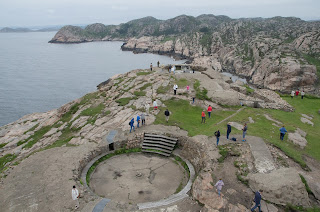On Maui, we signed up for one escorted trip, a Dolphin and Snorkeling cruise to the island of Lana’i. One thing we learned is that to say lanai (la-ni) is to speak of a patio. The name of the island is pronounced la-na-ee. The apostrophe matters.
 |
| Tour boat lineup |

Our hosts for this trip was the Pacific Whale Foundation, a study group that promotes research paid for in part by the money they make from these tours. We left from the Lahaina harbor on the Ocean Quest at 8:00 after checking in at their office on Lahaina's Front Street. As soon as we were all situated, the crew came around with water in biodegradable cups made from corn. This is one of the small steps they are taking to keep plastic out of the oceans. Even if they do happen to get blown or dropped overboard, they will really disintegrate, not just break down into ever smaller pieces of plastic to be eaten by marine life to their detriment. This was followed by a breakfast place with two pastries and slices of orange and pineapple.

Our ride to the snorkeling area is theoretically about 45 minutes, but we took twice that as we searched for and then stopped to observe four different cetaceans. The first of these were humpback whales. A few of the boys have arrived earlier than normal from their summer feeding trip to Alaska. Males do arrive first. Usually whale-watching season begins in mid-December, but this year the tours have already started. This area amongst the islands of Lana’i, Maui, and Kahoolawe will soon be host to tens of thousands of these magnificent creatures who have come to give birth and create more babies for next season. At the highlight of the season, whales can be seen literally on top of one another as they jostle for breeding position. For now, however, seeing any humpbacks requires a bit of luck. Our skipper said that on his whale-watching trip the day before, he’d been skunked. We saw at least six in three different groups. There was no breaching today, but it’s always exciting to see whales.

We had a short look at a few bottlenose dolphins, one of the three species that live in the area. They were quickly left behind as we had a report of some false killer whales closer to our snorkeling area. There are only a couple of hundred of these animals in the entire Hawaiian Islands so to see them would be quite special. This would be first for a couple of the crew members along with all of the passengers. These are a different species from the killer whales we have in the Salish Sea at home, but live a similar lifestyle catching and eating the largest fish in the area.

They are also highly social in behaviour. One of the experts on board told us about a research scientist friend of his who had been diving with some of these animals. One of them caught a large Mahimahi and proceeded to present it to the scientist who accepted it with as much grace as he could muster. He returned it when the false killer whale indicated he wanted it back. He then passed it around to the other whales before settling in to make a meal of it.
We also saw a pod of over 100 spinner dolphins. They are so-named because when they leap out of the water they will often spin two or three times before landing. They were a lot of fun to watch before we left them to head finally to Mahina Bay where we would spend a couple of hours snorkeling.

With 85 snorkelers, I expected a bottleneck getting off the boat and again once we were in the water. Two other boats of snorkelers added even to the mass of people I expected to be competing with once in the water. None of that happened. We separated ourselves getting in the water as we readied ourselves at different speeds and several on our boat first took advantage of the Snorkeling 101 class offered by the skipper. Then when we got into the water, we spread out easily. Our larger boat anchored a bit further out from shore than the others which meant we had about a 50 yard swim to where we could see the bottom. At that point we were in quite a large area of coral where we could watch the more than 50 species of fish swimming below. We were also lucky enough to see a turtle feeding on the bottom. A few people found one close to the surface to swim with a bit, but we missed that one. The highlights for me were the turtle and several different schools. Seeing those larger groups spending time together added to the excitement of their natural beauty and variety of colorations.

Once back on the boat, we were served lunch and drinks. Lunch consisted of a potato/macaroni salad and a bean salad along with a choice of hotdog, chicken burger, or veggie burger. A complimentary drink was a nice added touch with additional drinks for only three dollars. We did not see any more animals on our way back across the water to Lahaina, so we just relaxed and enjoyed the sun. The shower and nap when we returned to our condo finished the day nicely.


















































